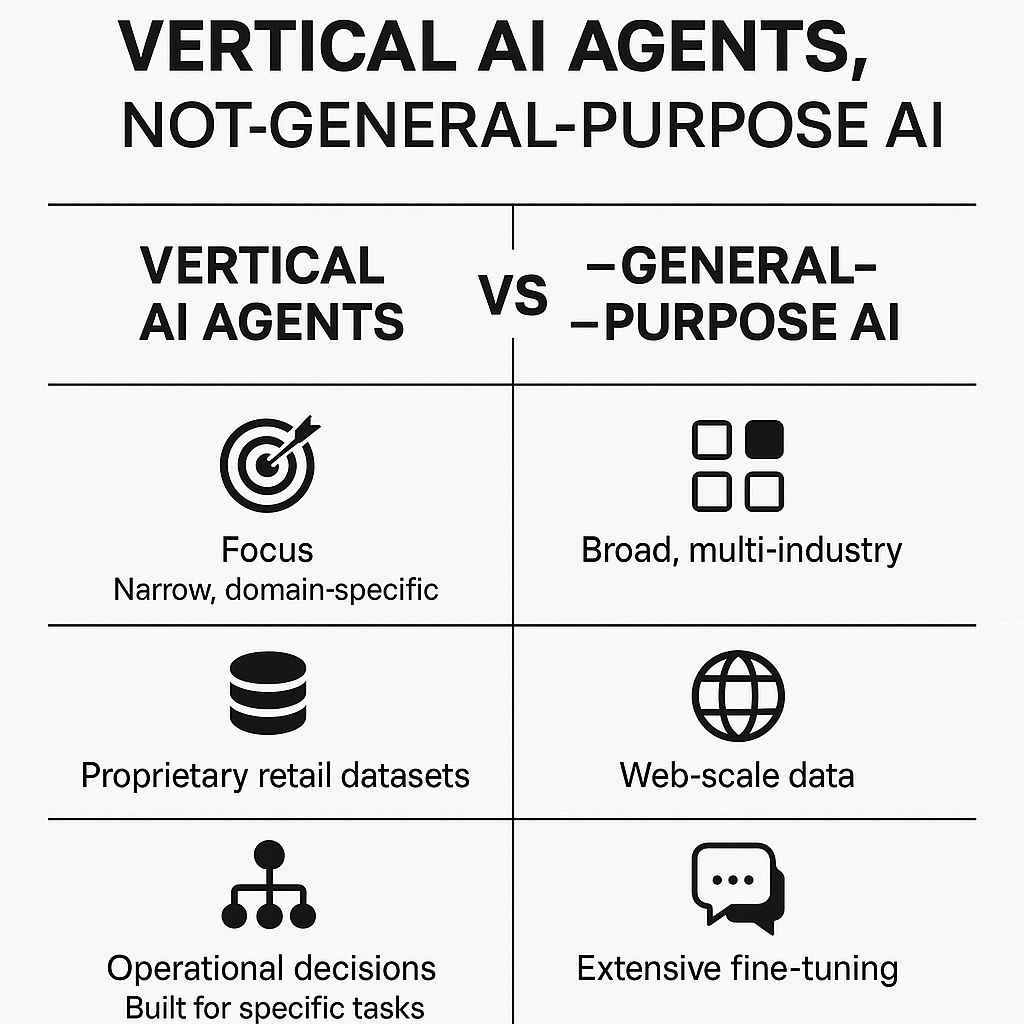Summary
Discover why horizontal AI tools like ChatGPT fall short for retail operations — and how vertical AI agents, built for specific domains like inventory optimization, influencer management, and local GEO marketing, deliver precision, ROI, and speed that general models can’t match.

Introduction
AI is no longer an experiment in retail — it’s the new operating system.
From inventory planning to creator partnerships, every retail function is being touched by automation. But not all AI is created equal.
While horizontal AI systems such as ChatGPT and Gemini are built to perform many tasks across many industries, they lack the deep, structured understanding retail businesses demand. Managing thousands of SKUs, predicting product trends, or evaluating influencer ROI requires context, data integration, and domain mastery — not just conversational ability.
That’s where vertical AI agents step in: purpose-built systems fine-tuned on retail data, designed to automate specific functions with precision, speed, and explainability.
Horizontal vs Vertical AI Agents: The Core Difference
| Aspect | Horizontal AI (e.g., ChatGPT) | Vertical AI (e.g., WorkfxAI Agents) |
| Focus | General-purpose; broad across industries | Narrow, deep expertise in one domain (retail, logistics, etc.) |
| Training Data | Public internet data | Proprietary retail datasets (POS, sales, influencers, SKU data) |
| Output | Conversational insights | Operational decisions & automations |
| Customization Need | Heavy fine-tuning and prompt engineering | Pre-built for specific retail workflows |
| Performance ROI | High error potential; limited context | Consistent accuracy; measurable ROI |
| Examples | ChatGPT writing a marketing email | WorkfxAI Agents optimizing inventory or influencer selection |
Horizontal AI is the “Swiss army knife.”
Vertical AI is the surgical tool — precise, trained, and business-ready.
The Hidden Costs of Horizontal AI in Retail
Many retailers start with horizontal AI because it feels flexible and accessible. But the cost of generalization quickly becomes apparent:
- Context Gaps = Wrong Answers
A horizontal AI might recommend “trending” products without knowing your sell-through rates, logistics costs, or regional pricing dynamics. → Result: wasted ad spend or stockouts. - Manual Overhead
Teams must spend hours writing prompts, training context, or fact-checking outputs — work that a vertical agent handles automatically. - Unreliable ROI
When AI doesn’t understand the nuances of retail data (e.g., product velocity, creator conversion, category seasonality), results are inconsistent — and trust erodes.
The Strategic Advantage of Vertical AI Agents
Vertical AI agents are designed to understand your data, your goals, and your customers.
They aren’t general chatbots — they’re embedded operators.
1. Precision Through Domain Expertise
A Product Trend Agent (like WorkfxAI’s) doesn’t guess what’s hot — it analyses verified sales data across 13 global markets to identify profitable SKUs with 30–45% growth potential.
2. Faster ROI & Less Training
An Influencer Agent already knows what a “high-GPM creator” looks like — analyzing actual sales per 1,000 views and providing fair pricing recommendations in minutes.
3. Operational Reliability
A GEO Management Agent is tuned for AI discoverability, ensuring your store surfaces not only in Google but in ChatGPT and Perplexity answers — the next frontier of retail visibility.
Vertical AI in Action: Retail Case Examples
1. Product Trend Intelligence
Agent: Ecommerce & Retail Product Trend AI Agent
Impact: Transforms guesswork into data-driven merchandising.
It identifies fast-growing SKUs using verified transaction data — not social buzz — reducing selection risk and improving sell-through by up to 70%.
2. Influencer Discovery & Selection
Agent: Influencer Agent
Impact: Finds creators who sell, not just post.
It matches brands with high-converting TikTok creators, projects ROI, automates outreach, and cuts manual research time from weeks to minutes.
3. GEO Management & Optimization
Agent: Ecom & Retail GEO Management Agent
Impact: Future-proofs brand visibility across both Google and AI engines.
It structures product data and content for AI citation, ensuring your brand is discoverable in AI-generated answers — not just search results.
Why Vertical Beats Horizontal Every Time
| Metric | Horizontal AI | Vertical AI |
|---|---|---|
| Setup Time | Weeks of prompt tuning | Plug-and-play |
| Error Rate | 25–40% hallucination risk | <5% (task-specific validation) |
| ROI Tracking | Indirect or subjective | Measurable KPIs: CTR, AOV, sales |
| Human Supervision | High (manual QA) | Minimal (embedded domain logic) |
| Integration with Retail Tools | Generic APIs | Native links to POS, CRM, ERP, Shopify, TikTok Shop |
How WorkfxAI Makes Vertical AI Accessible
WorkfxAI lets retailers build and deploy specialised agents — no data science team required.
Through its AI Workforce platform, brands can spin up tailored agents for:
- Product Trend Forecasting
- Influencer Optimization
- GEO Marketing
- Loyalty & Retention
- Supplier Operations
Each agent is pre-trained on retail datasets and can be connected directly to Shopify, WooCommerce, or ERP systems — reducing decision latency from days to minutes.
Conclusion: The Future is Vertical
Horizontal AI will always be broad.
But in retail — where margins are tight, competition fierce, and context everything — general-purpose AI can’t deliver the precision or trust you need.
The next wave of retail automation belongs to vertical AI agents — the specialists that turn data into execution, not just conversation.
So the question isn’t “Can AI help retail?”
It’s “Which AI is built for your business?”
Ready to see the difference?
Build your first specialised retail AI agent today with WorkfxAI — and experience how precision outperforms generalisation.
Start for free
Leave a Reply